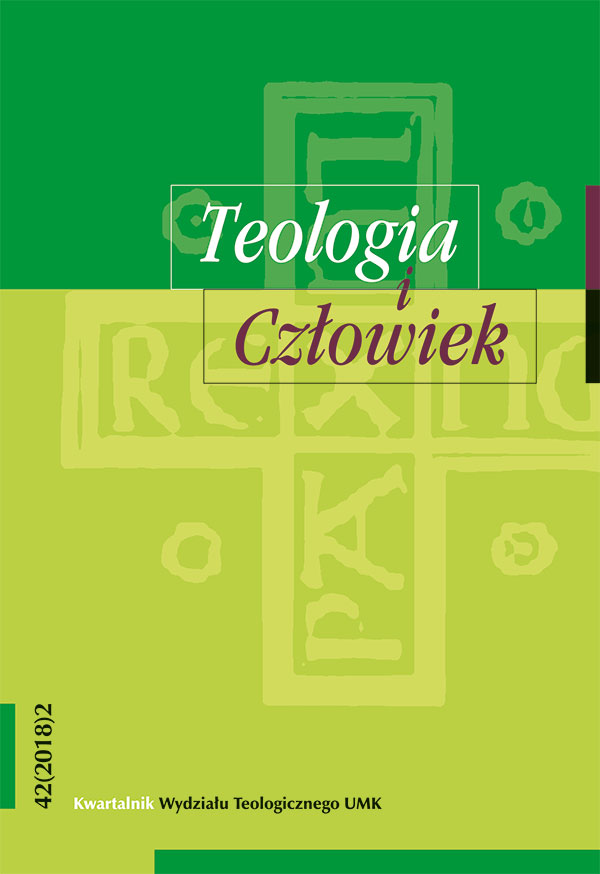Mariophany. The Figure of Virgin Mary in the Interreligious Dialogue
DOI:
https://doi.org/10.12775/TiCz.2018.021Keywords
Interreligious dialogue, Mariology, Christianity in AsiaAbstract
Author in the article tries to enter the interreligious dialogue using as his methodology the theology of interreligious dialogue of Raimundo Panikkar, which is significantly hermeneutical, making distinction between faith (action) and belief (the substance). The two micro narratives in this case, being the basis for the research, are historical events in Christian history: the clash of Christian tradition as well as: 1) Chinese civilization in Tang China; and 2) The Japanese civilization in 16th century Japan. By outlining and analyzing these two stories the author makes and attempt to enter the dialogue between Christianity and the Eastern thought, where the character of Virgin Mary is the key figure. The problem which is discussed here is following: how the figure of Mary could influence and inspire the traditional Asian societies, and what is the role of Mary in the pedagogy of God’s Revelation.
References
Andressen, C., Krótka historia Japonii. Od samurajów do Sony, Warszawa 2004.
Barrett, T. H., Buddhism, Taoism and the eighth-century Chinese term for Christianity: a response to recent work by A. Forte and others, “Bulletin of SOAS”, 65 (2002) 3, s. 555–560.
Benko, S., The Virgin Goddess: Studies in the Pagan and Christian Roots of Mariology, Leiden, Brill 2003.
Berzin, A., The Situations of Buddhism and Islam, 1996, http://www.berzinarchives.com/web/en/archives/study/islam/modern_interaction/situation_buddhism_islam_china.html (dostęp 20.02.2015).
Courth, F., Teksty teologiczne. Mariologia, red. E. Adamiak, Poznań 2005.
Deeg, M., Digging out God from the Rubbish Heap. The Chinese Nestorian Documents and the Ideology of Research, http://repository.kulib.kyoto-u.ac.jp/dspace/bitstream/2433/65875/15/12Deeg.pdf (dostęp 20.02.2011)
Deeg, M., The “Brilliant Teaching”. The Rise and Fall of “Nestorianism” (Jingjiao) in Tang China, “Japanese Religions”, vol. 21 (2), s. 91–110.
Shusaku, E., Milczenie, tłum. I. Denysko, Warszawa 1986.
Gilhooly, R., Signs of The Cross in China, “The Japan Times online”, http://search.japantimes.co.jp/cgi-bin/fv20010724a1.html (dostęp 15.01.2011).
Goddesses Who Rule, red. E. Benard, Beverly Moon, New York 2000.
Harrington, A. M., The Kakure Kirishitan and Their Place in Japan’s Religious Tradition, “Japanese Journal of Religious Studies” 7 (1980) 4, s. 31–-336.
Kawai, H., The Transformation of Biblical Myths in Japan, “Diogenes”, 42/1 (1994) 165, s. 49–66.
Lieu, S., Epigraphica Nestoriana Serica, w: Iranica, Band. 17, Harrassowitz Verlag 2009, s. 227–246.
Nakamura, H., Pure Land Buddhism and Western Christianity Compared: A Quest for Common Roots of their Universality, “International Journal for Philosophy of Religion” 1 (1970) 2, s. 77–96.
Netland, J. T., From Cultural Alterity to Habitations the of Grace: The Evolving Moral Topography of Endo’s Mudswamp Trope, “Christianity and Literature” 59 (2009) 1, s. 27–48.
Nosco, P., Secrecy and the Transmission of Tradition. Issues on the Study of “Underground” Christians, “Japanese Journal of Religious Studies” 20 (1993) 1, s. 3–29.
Panikkar, R., Religie świata w dialogu, tłum. J. Marzęcki, Warszawa 1986.
The Beginning of Heaven and Earth. The Sacred Book of Japan Hidden Christians, tłum. Ch. Whelan, University of Hawaii 1996.
The Kuan-Yin Chronichles. The Myths and Prophecies of the Chinese Goddess of Compassion, M. Palmer, J. Ramsey, Man-Ho Kwok, Charlottesville 2009.
The Lost Sutras of Jesus. Unlocking the Ancient Wisdom of Xian Monks, red. R. Riegert, Thomas Moore, Souvenir Press 2003.
Deeg, M., Towards a New Translation of the Nestorian Documents from the Tang Dynasty, w: Jingjiao. The Church of the East China and Central Asia, red. R. Malek in connection with P. Hofrichter, Institut Monumenta Serica 2006, s. 115–131.
Turnbull, S., Mass or Matsuri?: The Oyashiki-Sama Ceremony on Ikitsuki, “Monumenta Nipponica” 50 (1995) 2, s. 171–188.
Turnbull, S., The Kakure Kirishitan of Japan, A study of their development, beliefs and rituals to the present day, Richmond 1998.
Whelan, Ch., Religion Concealed. The Kakure Kirishitan on Narushima, “Monumenta Nipponica” 47 (1992) 3, s. 368–387.
Widengren, G., Fenomenologia religii, tłum. J. Białek, Kraków 2008.
Williams, P., Buddyzm Mahajana, tłum. H. Smagacz, Kraków 2000.
Yü Chün-Fang, Kuan-Yin, The Chinese Transformation of Avalokitesvara, New York 2001.
Downloads
Published
How to Cite
Issue
Section
License
CC BY ND 4.0. The Creator/Contributor is the Licensor, who grants the Licensee a non-exclusive license to use the Work on the fields indicated in the License Agreement.
- The Licensor grants the Licensee a non-exclusive license to use the Work/related rights item specified in § 1 within the following fields: a) recording of Work/related rights item; b) reproduction (multiplication) of Work/related rights item in print and digital technology (e-book, audiobook); c) placing the copies of the multiplied Work/related rights item on the market; d) entering the Work/related rights item to computer memory; e) distribution of the work in electronic version in the open access form on the basis of Creative Commons license (CC BY-ND 3.0) via the digital platform of the Nicolaus Copernicus University Press and file repository of the Nicolaus Copernicus University.
- Usage of the recorded Work by the Licensee within the above fields is not restricted by time, numbers or territory.
- The Licensor grants the license for the Work/related rights item to the Licensee free of charge and for an unspecified period of time.
FULL TEXT License Agreement
Stats
Number of views and downloads: 1366
Number of citations: 0



